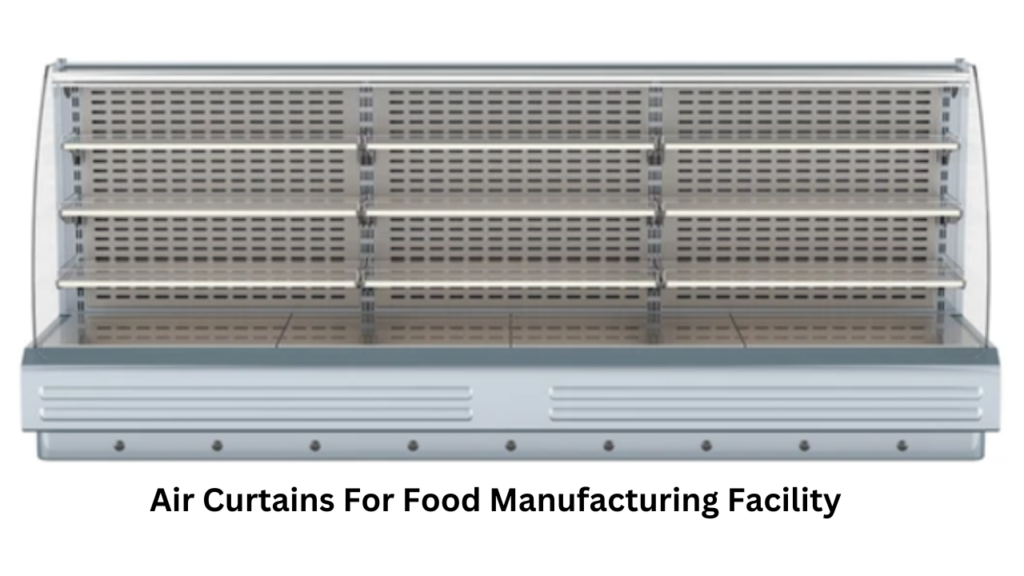
In the food manufacturing industry, maintaining hygiene, controlling temperatures, and preventing contamination are paramount. One of the unsung heroes of this process is the air curtain—a device that creates an invisible barrier of air to keep out contaminants while enabling easy access to and from various areas. Selecting the right air curtain is not only a matter of ensuring cleanliness but also energy efficiency and compliance with food safety standards. Here’s everything you need to know to choose the right air curtain for your food manufacturing facility.
What Are Air Curtains and Why Are They Important in Food Manufacturing?
Air curtains are installed above doorways or entrances to create a consistent airflow that blocks out contaminants like dust, insects, and odors. For food manufacturers, they serve several critical functions:
- Maintain Hygiene and Safety: Air curtains prevent outside air, along with airborne contaminants, from entering clean areas, such as processing, packaging, and storage rooms.
- Temperature Control: They minimize temperature fluctuations, especially in temperature-sensitive zones like cold storage, making it easier to maintain a controlled environment.
- Energy Savings: By preserving the indoor temperature, air curtains reduce the strain on heating and cooling systems, which leads to lower energy costs and increased efficiency.
These benefits make air curtains an indispensable part of food manufacturing facilities, where regulatory standards require high levels of cleanliness and safety.
Key Technical Aspects to Consider
When choosing an air curtain for food manufacturing, several technical aspects must be carefully evaluated to ensure it meets the specific needs of the industry.
1. Air Velocity and Volume
The primary function of an air curtain is to create a strong barrier that can block contaminants and control airflow. The right air curtain should provide enough velocity and volume to cover the full entryway, ensuring an uninterrupted air barrier. However, it’s essential to select a model with adjustable airspeed to avoid disturbing work areas or blowing away light materials within the facility.
2. Mounting Height and Width
An air curtain needs to fit the dimensions of the doorway or entry precisely. Measure the entryway height and width to ensure the curtain can fully cover the area. For larger or high-traffic doors, opt for models designed to maintain a robust airflow at greater heights, ensuring effective containment even with tall entries or large doorways.
3. Air Filtration
In food manufacturing, air quality is crucial. Opt for air curtains with high-grade filters, like HEPA filters, to capture dust, particles, and even microorganisms. A good filtration system in the air curtain will help maintain a sterile environment, particularly beneficial in packaging and processing areas where contaminants pose serious risks.
4. Temperature Control and Energy Efficiency
Air curtains should support energy-efficient operations. Look for models with temperature controls, which allow them to operate in coordination with heating, ventilation, and air conditioning (HVAC) systems. This feature will help you maintain ideal temperatures, reduce energy waste, and ultimately lower operational costs.
5. Noise Level
Since food manufacturing environments require high focus and concentration, an air curtain’s noise level is an important factor. Many models are designed to operate quietly, making them ideal for areas where noise could be disruptive or problematic. Low-noise options are generally better suited to food facilities, particularly in enclosed processing zones.
6. Corrosion Resistance and Food-Safe Materials
Food manufacturing often involves exposure to moisture, cleaning chemicals, and sometimes aggressive sanitization procedures. Therefore, air curtains made from corrosion-resistant materials like stainless steel are ideal. Food-safe coatings can further extend their longevity and ensure they remain clean and free from corrosion.
7. Compliance with Safety and Hygiene Standards
In the food industry, compliance with hygiene and safety standards is non-negotiable. Look for air curtains that are NSF (National Sanitation Foundation) certified or meet other relevant standards for food processing equipment. Compliance with these certifications ensures the air curtain will perform safely and hygienically in your environment.
8. Ease of Maintenance
Regular maintenance of air curtains is essential in food environments to prevent contaminants from accumulating and to ensure consistent performance. Choose models with easy-to-access filters and components, so that routine cleaning and maintenance can be performed quickly without needing specialized tools. Regular maintenance also reduces the risk of breakdowns and extends the lifespan of the unit.
Benefits of Using Air Curtains in Food Manufacturing
- Enhanced Cleanliness and Sanitation: Air curtains block unwanted particles and pests, supporting clean production areas and helping facilities meet stringent hygiene regulations.
- Stable Temperature Control: By reducing temperature loss at entryways, air curtains support efficient operation of cold storage and temperature-sensitive areas.
- Cost Savings on Energy: With better thermal regulation, air curtains reduce energy consumption, leading to significant savings over time.
- Improved Air Quality: High-quality filtration helps to improve indoor air quality, which is crucial for food safety and the health of workers.
- Compliance with Regulations: By choosing certified and industry-compliant air curtains, food manufacturers can more easily meet regulatory standards and avoid costly penalties.
Choosing the Right Air Curtain for Your Facility
Choosing an air curtain tailored to your food manufacturing facility requires a balance of airflow strength, material durability, energy efficiency, and compliance. Evaluate your facility’s specific needs, such as high-traffic areas, temperature requirements, and sanitation protocols. Consulting with an air curtain specialist can also be invaluable in selecting a model that meets these criteria and ensures efficient, uninterrupted operation.
Final Thoughts
In food manufacturing, air curtains are more than just an accessory—they are a vital part of maintaining a clean, safe, and efficient production environment. With the right air curtain, you can protect your facility from contaminants, keep your energy costs down, and ensure that your products are manufactured in a safe and compliant setting. Prioritize the technical aspects mentioned above, and your air curtain investment will pay off in reliable performance, improved air quality, and long-term savings.
At Atmaxfiltration we follow these guidelines, so that food manufacturers can make an informed decision that not only supports compliance but also enhances the overall productivity and safety of their facilities.
